79 F. high in the Twin Cities Wednesday.
80 F. average high on June 17.
82 F. high on June 17, 2014.
.87″ rain fell at Twin Cities International Airport yesterday.
June 17, 2010: The largest single-day tornado outbreak in Minnesota history occurred with 48 tornadoes across the state, and set the stage for a record breaking tornado year that finished with 113 tornadoes statewide. There were three EF-4 tornadoes and four EF-3 tornadoes in Minnesota on this day. Four tornado fatalities occurred, which was the highest number since July 5, 1978.
June 17, 1954: Hailstorm at St. Cloud injures many people.
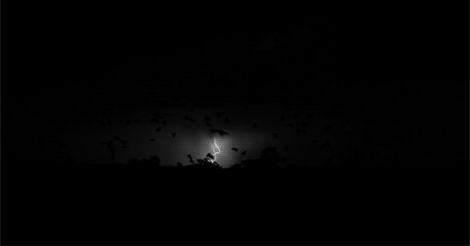
Oldies But Goodies
We are drowning in technology; a proliferation of apps, scripts, sensors, data in the cloud – good luck trying to keep up. All this tech gives the illusion of control, when in fact we have precious little.
With weather there’s a perception that web sites, apps and local media will save you when skies turn threatening. “Hey, I can wait until the last moment, then make a mad dash!” Don’t push the weather, especially when skies turn severe.
The old ways are still the best ways. Very large hail is a often a tip-off that a thunderstorm updraft is strong enough to spin up a tornado. Frequent lightning often means a severe storm is approaching. Weather approaching from the east is trouble. And if you hear thunder head inside right away – don’t wait until you see lightning. People have been struck dead with blue sky overhead, the storm 10 miles away.
Minnesota will teeter on the northern edge of baking heat in the coming weeks. 90s stay south, but a few 80s are likely; dew points high enough to fuel a few severe T-storms Friday. The best chance of weekend thunder: Saturday morning and Sunday evening.
Warm enough for a dip in the lake, but nothing too sweaty brewing anytime soon.
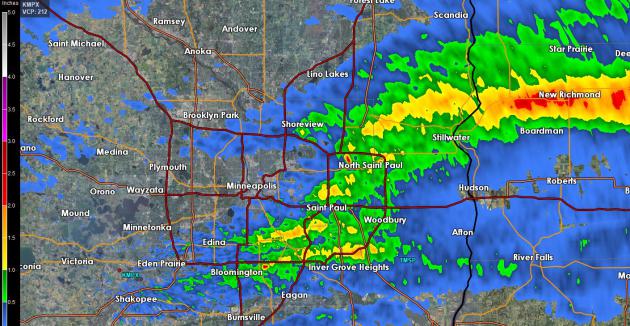
Soaking Storms Southern and eastern Metro Wednesday. The map above shows Doppler-estimated rainfall amounts from yesterday, over 1″ from Bloomington and Richfield into St. Paul and many eastern suburbs, closer to 2″+ near New Richmond.
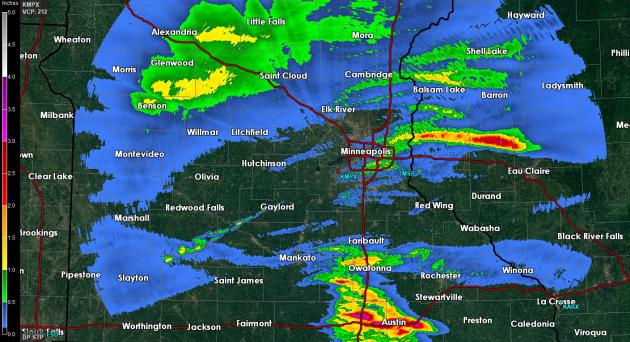
Tornado Reported Near Amery, Wisconsin. You can clearly see the path of two supercell thunderstorms that went on to produce not only drenching rains but large hail; over west central Wisconsin and in the Albert Lea – Austin area near I-90. Significant rains soaked much of central Minnesota with over 1″ from Benson and Alexandria to Little Falls. The Twin Cities office of the National Weather Service is investigating reports of a tornado near Amery.
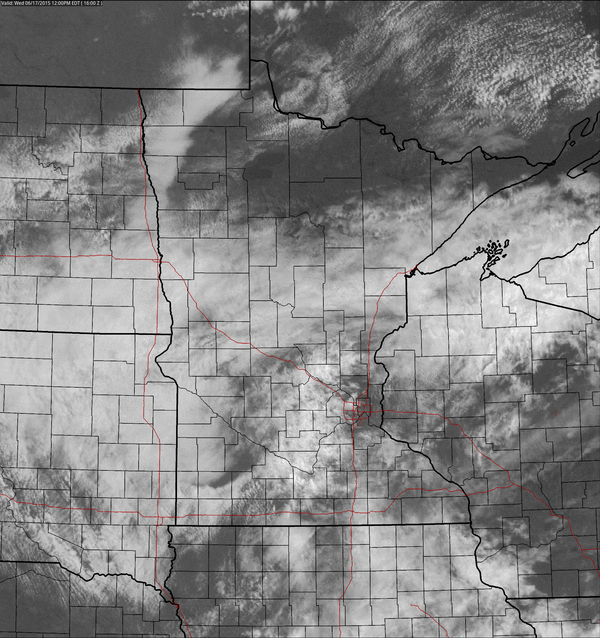
Reverse Lake Effect. Cooler lake water inhibited cumulus formation yesterday over northern Minnesota – you can clearly see a lack of clouds over the lakes during the afternoon hours. Source: AerisWeather.

Moderately Warm – Moderately Wet. Minnesota will teeter on the edge of (real) heat over the next couple of weeks, sparking a few episodes of heavy T-storms. Temperatures run pretty close to average overall; no extreme heat or humidity is brewing as a persistent flow out of Canada keeps sizzling 90s well south of Minnesota. A few strong T-storms are possible late Friday into Saturday morning, more instability T-showers sprouting Sunday afternoon. Source: Weatherspark.
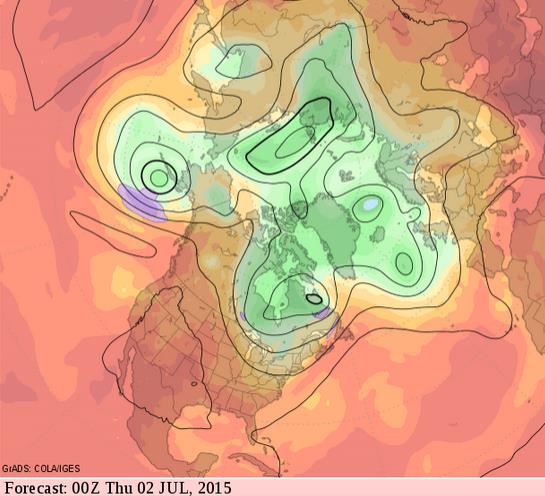
Misplaced Cut-Off Low. Temperatures are forecast to be much below average over the eastern half of Canada as an odd whirlpool of almost April-like air lingers over Hudson Bay. Some of that cooler, drier air will circulate into Minnesota, keeping temperatures close to average for the next 2 weeks. After that all bets are off.
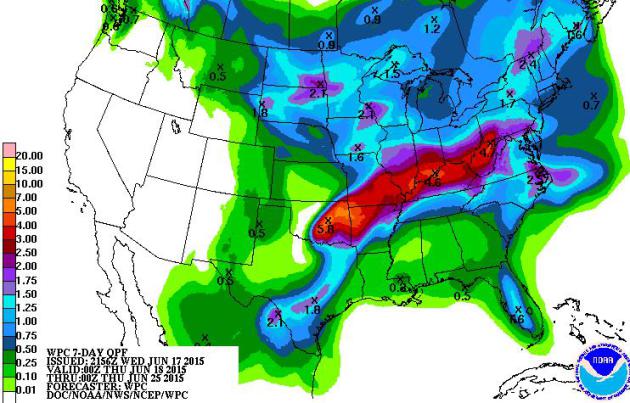
Soggy Runway. You can see the projected path of the storm formerly known as Bill, stretching from Oklahoma into southern Missouri and much of the Ohio Valley. 4-6″ rainfall amounts will be common with a few isolated 8″ rains capable of serious flash flooding from Tulsa and the Ozarks to St. Louis, Louisville and Cincinnati. Source: NOAA.

Tracking The Soggy Remains of “Bill”. NAM guidance from NOAA shows the swirl of leftover moisture from Tropical Storm Bill moving very slowly today, tracking from near Oklahoma City to Joplin and St. Louis, producing more flooding rains. In fact Bill will spike T-storms as far east as Pittsburgh, possibly Philadelphia and Washington D.C. by Sunday. Source: NOAA.

Track Update. Computer models seem fairly uniform in taking Bill’s tropical remains across the Middle Mississippi Valley into the Ohio Valley and Pennsylvania within 96 hours, before being swept out into the Atlantic Ocean. Relatively slow forward speed the next 72 hours will heighten the flash flood and river flood threat from Oklahoma into Illinois. Map source: Tropical Tidbits.
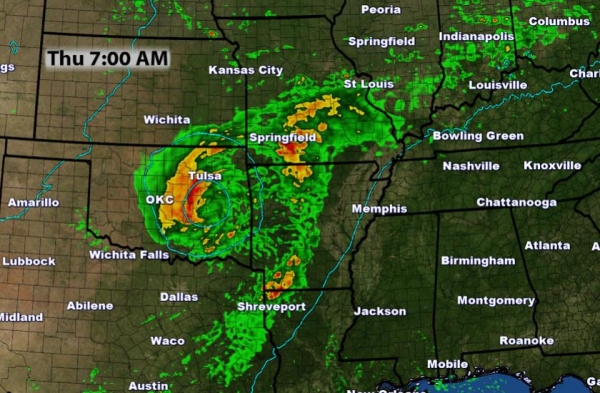
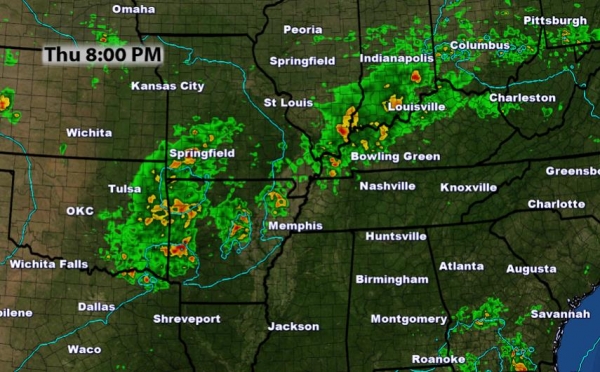
Timing The Storm. Our computer models suggest an extended period of excessive rains across Oklahoma later from today into midday Thursday, capable of some 10-12″ amounts. I could see extreme flooding from Ardmore and Oklahoma City to Tulsa impacting transportation and other infrastructure. Moisture leftover from Bill soaks St. Louis, Evansville, Indianapolis, Louisville and Cincinnati within 36-48 hours. Map sequence above: AerisWeather.

Total Rainfall Predictions. Some of the most extreme rainfall amounts are (consistently) predicted for central Oklahoma, 75 miles either side of I-35. It’s going to be a long 48 hours for Oklahoma City. Map: WeatherBell.

Arc of Flood Risk Extends Into Ohio Valley. NOAA’s high-resolution 4 km WRF model prints out some 3-6″ amounts from Louisville and Indianapolis to Fort Wayne, Columbus, Cincinnati and Pittsburgh. Interactions with the Appalachians may enhance tropical rainfall amounts, and I could see flash flooding problems by the weekend as far east as West Virginia and Pennsylvania.
Summary: Bill is no longer a tropical storm, but the threat posed by Bill is far from over. Although winds will gradually subside, along with the risk of isolated tornadoes in Bill’s spiral bands, the prospect of torrential rain lingers in a long arc from Dallas and Oklahoma City into the Ohio Valley in the coming days. It’s impossible to determine with precision where the most extreme rainfall amounts will set up, but conditions are ripe for more urban and river flooding as the tropical remains of Bill continue to pinwheel across the USA.
Paul Douglas, AerisWeather Senior Meteorologist


June 17, 2010: Minnesota’s Craziest Tornado Day. Here’s a PDF summary of the 48 tornadoes that touched down (just in Minnesota) on one day in June of 2010, courtesy of the Twin Cities National Weather Service.
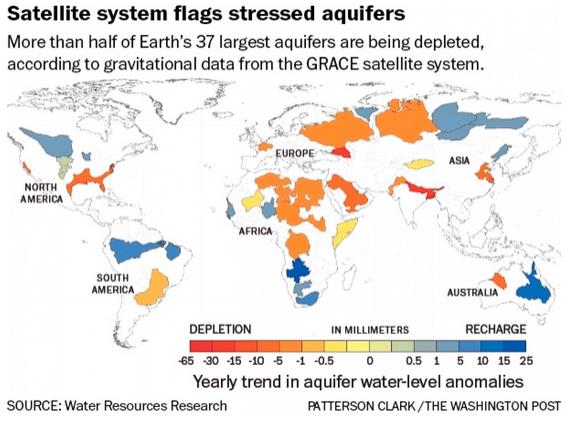
New NASA Data Show How The World Is Running Out of Water. The things we tended to take for granted in the 20th century we will not be taking for granted in the 21st. Like access to clean, reliable water supplies. Here’s an excerpt from The Washington Post: “The world’s largest underground aquifers – a source of fresh water for hundreds of millions of people — are being depleted at alarming rates, according to new NASA satellite data that provides the most detailed picture yet of vital water reserves hidden under the Earth’s surface. Twenty-one of the world’s 37 largest aquifers — in locations from India and China to the United States and France — have passed their sustainability tipping points, meaning more water was removed than replaced during the decade-long study period, researchers announced Tuesday...”
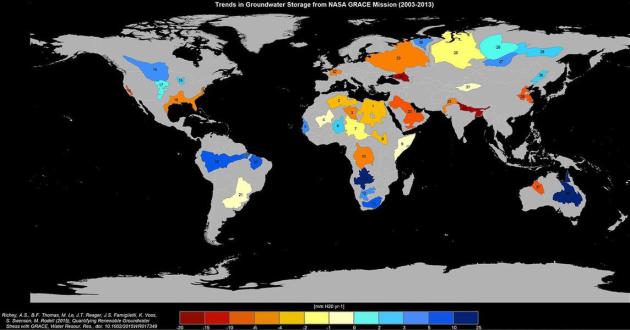
Earth’s Largest Groundwater Aquifers Are Past “Sustainability Tipping Points”. Andrew Freedman has more perspective on the NASA research referenced above at Mashable; here’s an excerpt: “…The fact that the majority of the world’s groundwater accounts “are past sustainability tipping points” was not known before, according to James Famiglietti, an author of both studies and a professor of Earth system science at the University of California, Irvine and senior water scientist at NASA’s Jet Propulsion Laboratory. Such points are crossed when groundwater aquifers are no longer being replenished as quickly as they are being depleted, Famiglietti told Mashable in an interview. Both studies appear Tuesday in the journal Water Resources Research. Famiglietti and his coauthors call for a global effort to determine how much water is left in the world’s most important aquifers…”
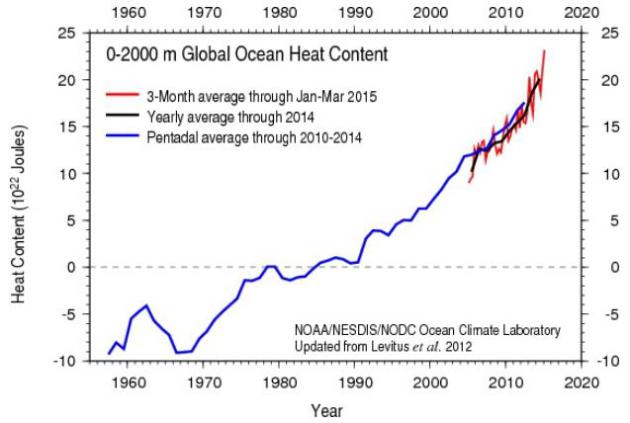
2015 May Bring Long-Awaited Step-Jump in Global Temperatures. 90% of warming goes into the world’s oceans and it would appear that some of that warming is now coming out of the oceans and into the atmosphere. Here’s a snippet from ThinkProgress: “…Climatologist Kevin Trenberth has explained that “a global temperature increase occurs in the latter stages of an El Niño event, as heat comes out of the ocean and warms the atmosphere.” This week, NOAA released its monthly El Niño Southern Oscillation [ENSO] report, which concludes, “There is a greater than 90% chance that El Niño will continue through Northern Hemisphere fall 2015, and around an 85% chance it will last through the 2015-16 winter...”

El Nino 2015 Forecast To Intensify And Last Through Winter. Al.com has a good explainer on El Nino, and how the effects, especially a wetter trend for California where they desparately need rain, may kick in later in the year – here’s an excerpt: “Looks like El Nino is going to stay with us for a while. A monthly report assessing El Nino’s status, released this week, said there was a greater than 90 percent chance El Nino will continue through the fall, and an 85 percent chance it will last through the winter. El Nino is the term used for the warming of the equatorial waters of the Pacific off the west coast of South America. Those warmer waters can change global weather patterns. This El Nino could be a strong one, according to climate experts. But what does that mean for the United States?..”

The Latest Global Temperature Data Are Breaking Records. Dr. John Abraham at St. Thomas has an article for The Guardian; here’s an excerpt: “Just today, NASA released its global temperature data for the month of May 2015. It was a scorching 0.71°C (1.3°F) above the long-term average. It is also the hottest first five months of any year ever recorded. As we look at climate patterns over the next year or so, it is likely that this year will set a new all-time record. In fact, as of now, 2015 is a whopping 0.1°C (0.17°F) hotter than last year, which itself was the hottest year on record. Below, NASA’s annual temperatures are shown. Each year’s results are shown as black dots. Some years are warmer, some are cooler and we never want to put too much emphasis on any single year’s temperature. I have added a star to show where 2015 is so far this year, simply off the chart…”

Image credit above: “Road markings appear distorted as the asphalt starts to melt due to the high temperature in New Delhi, India, 27 May 2015.” Photograph: Harish Tyagi/EPA.
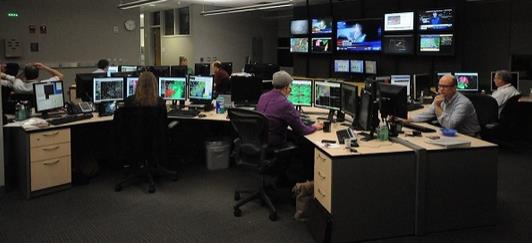
Senate Bill Proposes Centralizing Weather Service Forecasting in 6 Regional Offices. Streamlining, cost-cutting, “achieving greater efficiencies”. It may save a few bucks but you’re losing the institutional memory and forecasting ability in each local NWS office. I don’t see how this makes the forecasts (or warnings) any more effective, and it may wind up endangering public safety. Here’s an excerpt from The Capital Weather Gang: “The Senate Commerce Committee is introducing a bill on Tuesday that would consolidate forecasting at 122 National Weather Service (NWS) forecast offices into six regional offices. The measure and its supporters argue that it would make NWS forecast operations more efficient and nimble while saving money. Opponents say it would reduce jobs and significantly compromise forecast quality by dispersing the trove of local knowledge within the nation’s forecasting network...”

Google’s New Project Is So Insanely Advanced It Will Blow You Away. Uh huh. It looks cool, but where’s my flying car? Here’s an excerpt from mensxp.com: “If Google has its way, our future will be nothing less than a sci-fi movie. After creeping us out with a robotic cheetah and the Google ‘Glass’, Google is all set to bring forth something really amazing. Google’s Project Soli has invented a new interaction sensor using radar technology that can capture motions of your fingers at up to 10,000 frames per second. And that is something that has never ever been done before. Simply put, this technology is so bafflingly accurate that you could operate any device (fitted with this) without having to even touch it...”

Neurosurgeon To Attempt World’s First Head Transplant. Can I at least have a new head with more hair? And a more pleasant disposition? Al Jazeera has the details, which sound like something you might find on the SyFy Channel: “…An Italian neurosurgeon has unveiled plans to perform the first human head transplant by the end of 2017. Dr Sergio Canavero announced his plan at the annual meeting of the American Academy of Neurological and Orthopaedic Surgeons in the US state of Maryland on Friday, saying he believes he has a 90 percent chance of success. He said his patient will be a 30-year-old Russian man, Valery Spiridonov, who has the muscle-wasting disease, Werdnig-Hoffmann...”

Meet The Blobfish. Yes, beauty is in the eye of the beholder, but what was he thinking when he created…this? Discovery Blog has more information; here’s an excerpt: “…Endemic to the deep waters off of mainland Australia, the blobfish is comprised mainly of gelatinous flesh. Due to the low density of its flesh, the innocuous blobfish floats leisurely near the ocean floor, quietly gobbling down small crustaceans and other edible matter that floats into its mouth. According to NOAA, that’s about all it can do — it has very little muscle, so actively hunting prey is nearly impossible…”
Photo credit: Grufnik via Flickr (Creative Commons).

TODAY: Partly sunny and pleasant. Umbrella optional. Winds: NW 10. High: 79
THURSDAY NIGHT: Partly cloudy and dry. Low: 63
FRIDAY: Warm sun, severe storms late in the day or at night? High: 82
SATURDAY: Some sun, lingering storm risk. Wake-up: 69. High: 84
SUNDAY: Warm sun, late day T-showers. Wake-up: 67. High: 83
MONDAY: Sunny start, late-day thunder. Wake-up: 64. High: 81
TUESDAY: Intervals of sticky sun. Dew point: 65. Wake-up: 66. High: 86
WEDNESDAY: Shocker: more scattered T-storms. Wake-up: 63. High: 81
Climate Stories…
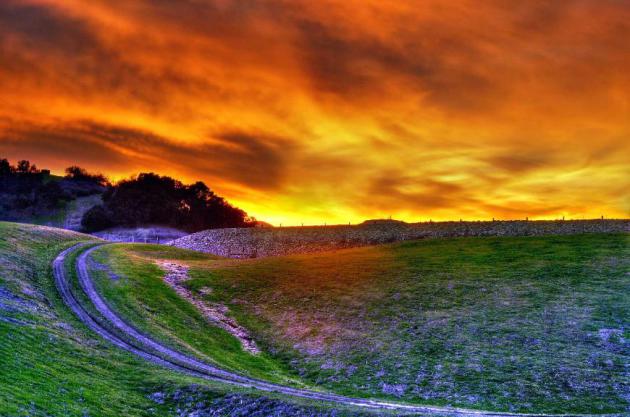
Catholics Divided Over Global Warming. Here’s an excerpt of new poll results from the Pew Research Center: “…About seven-in-ten U.S. Catholics (71%) believe the planet is getting warmer. Nearly half of Catholic adults (47%) attribute global warming to human causes, and a similar share (48%) view it as a very serious problem. But more than eight-in-ten Catholic Democrats say there is solid evidence that Earth is warming, compared with just half of Catholic Republicans.1 And while six-in-ten Catholic Democrats say global warming is a man-made phenomenon and that it poses a very serious problem, only about a quarter of Catholic Republicans agree...”

How The Pope Got Religion on Climate Change. Eric Roston has some very interesting background on why Pope Francis is expected to come out so strongly on climate change with today’s encyclical. Here’s an excerpt from Bloomberg Business: “…Ramanathan, who is Hindu, reassembled his message in time, and in English. No pressure. All he had to do was sum up more than a century of thought and research that in the past two decades has been validated repeatedly by climate scientists globally. “We are concerned about climate change,” he told Francis. “The poorest 3 billion people are going to suffer the worst consequences.” Ramanathan is one of many scientists and other advisers who have, over the last several decades, conveyed the urgency of climate change to the Vatican. Now, Francis is responding…”

Pope’s Views on Climate Change Add Pressure to Catholic Candidates. Here’s a clip from an article at The New York Times: “…Archbishop Wenski will repeat those messages in his sermons, and he hopes that they will resonate with two members of his flock in particular: Florida’s junior senator, Marco Rubio, and Jeb Bush, a former governor, both Catholics and both Republican presidential candidates. Like many Republicans, Mr. Bush and Mr. Rubio have questioned or denied the established science of human-caused climate change, and harshly criticized policies designed to tax or regulate the burning of fossil fuels. Both of their campaigns have courted influential and deep-pocketed donors, such as the billionaire brothers Charles G. and David H. Koch, who vehemently oppose such climate policies…”
AP file photos above left: David Goldman. Upper right: Molly Riley.

Climate Change Denial – The Dangerous Lie. Here’s a snippet of an Op-Ed at The Hill: “…Thwarting America’s ability to reduce the greenhouse gas emissions causing all this climate chaos, however, is a misinformation industry funded by entities that profit off fossil fuels and by billionaires using their outsized resources to purchase a political agenda aligned with their anti-government beliefs. Hundreds of millions of dollars are being pumped into phony think tanks and political coffers at the federal, state and local levels to protect the carbon economy. Climate change is impacting every part of our society, from our security to our economy to our health. We know what’s causing it. And we know how to stop it. Yet a few bad actors are getting in the way, sowing doubt on the airwaves, doubling down on dirty energy and paying off politicians so that no one in Washington, D.C., dare lead us toward a healthier, more sustainable energy agenda...”

Climate Deniers Are Quickly Bringing About Their Worst Nightmare. Naomi Oreskes (who co-authored “Merchants of Doubt”) has a long, detailed and important post at The Nation; here’s an excerpt: “…Many Republicans resist accepting the overwhelming scientific evidence of climate change because they fear it will be used as an excuse to expand big government. Here’s what should give them pause: by delaying action on reducing global carbon emissions for more than two decades, we have already significantly increased the likelihood that disruptive global warming will lead to the kinds of government interventions they most fear and seek to avoid. Climate change is, in fact, already causing an increase in the sorts of extreme weather events—particularly floods, extreme droughts, and heat waves—that almost always result in large-scale government responses. The longer we wait, the more massive the required intervention will be…”
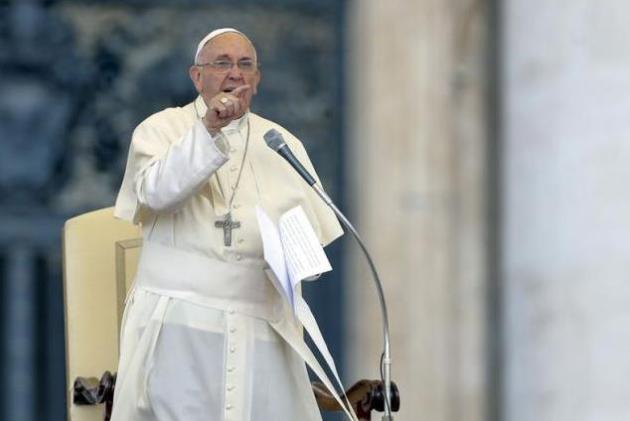
Pope Calls For Action on Climate Change in Draft Encyclical. Will Pope Francis be able to ultimately move the needle? The optimist in me says yes, but nothing will come easily, or quickly. There’s just too much money in play for it to happen without a fight. Reuters has the story; here’s the introduction: “Pope Francis makes an urgent call for protection of the planet and repeats his view that global warming is mostly man-made in his keenly awaited encyclical, according to a draft published by an Italian magazine on Monday. The Vatican said the document, leaked in its Italian edition by the magazine l’Espresso, was not the final version, which would remain under embargo until its release on Thursday...”
Photo credit above: “Pope Francis delivers a speech during an audience for the participants of the Convention of the Diocese of Rome in St. Peter’s square at the Vatican City, June 14, 2015.” Reuters/Giampiero Sposito.

Pope: Climate Change a Moral Issue And Due To Human Activity. USA TODAY reports on the leaked copy of Pope Francis’s Encyclical, due to be released on Thursday; here’s an excerpt: “…The draft is broken into six chapters, with headings such as “what is happening to our house,” “the human roots of the ecological crisis” and “integrated ecology.” According to the leaked document, the pope says the world is addicted to a “culture of waste.” The draft also says, “Humanity is called on to be aware of the need to change lifestyles, production and consumption.” The pope describes a “scientific consensus … (about a) worrisome warming of the climate system…” (Apollo 8 file image: NASA).
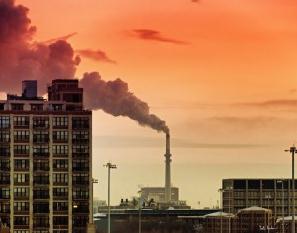


Hi Paul–I especially appreciated your post and column today because of what happened yesterday regarding my son who is a lifeguard at Cascade Bay in Eagan. In spite of dark threatening clouds, pouring rain and on-going, increasingly loud thunder, the park was not closed because they have the following policy: they only close when someone on staff actually spots lightning or when a certain Eagan city employee devines from radar that they ought to. They did not close until a huge crack of thunder and lightning bolt came down in very close proximity to the park. The guards were getting very nervous about the situation, but their hands are tied by the policy and they have no say. I contacted the facilities manager about this immediately yesterday afternoon, who confirmed the policy and defended it. I am not going to let this go until I get them to be sensible (the old rule way back in the day when I was a lifeguard: If you hear it, time to clear it.). Thanks for the ammunition!